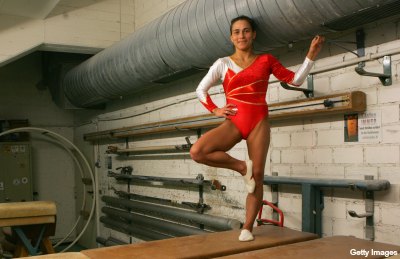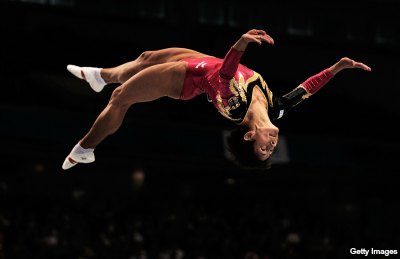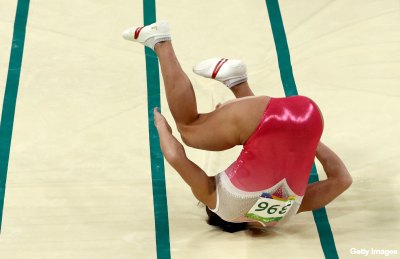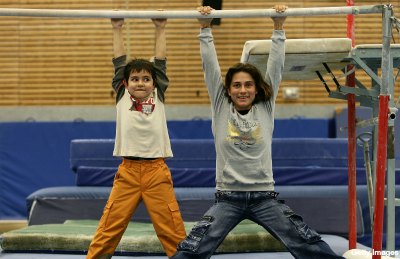At 21, Aly Raisman is considered an old woman in a sport dominated by teenagers. Her decision to return for the 2016 Summer Olympic Games was met with surprise and admiration for her determination, given her ripe old age.
Those voices were even more stunned when Raisman -- nicknamed "Grandma Aly" by her teammates -- not only returned after a fourth-place all-around finish in 2012, but turned in an even better performance with a silver medal. But Raisman's age-defying career has nothing on Oksana Chusovitina, who competed in the vault Sunday at a staggering 41 years of age.
Chusovitina, competing for Uzbekistan, has now appeared in seven Olympic Games, going all the way back to 1992. None of this year's USA gymnastics team were alive to see it -- Chusovitina appeared in two Olympics before Simone Biles was born.

The 5-foot, 97-pound gymnast has represented three different countries during her career, starting with the former USSR. From 2006 to 2012, she lived in and competed for Germany, where she had moved while her son received treatment for leukemia.
Now even her son, 17, is older than some of the competitors Chusovitina faced at this year in Rio. She won a team gold in 1992 with the USSR, and a silver medal in vault at the 2008 Olympics -- a 16-year medals gap that is the largest in gymnastics history. As recently as 2012, she won a silver medal in vault at the European Championships.
Her career has endured beyond a point most gymnasts can't even imagine. And Chusovitina is nowhere close to finished -- the told The New York Times she has her sights set on Tokyo in 2020.
"This is a kind of experiment," she tells The New York Times. "I would like to see how long I can compete."
Desire is one thing. But Chusovitina's ability to extend her gymnastics career is something the sports world can only gawk at. After her seventh-place finish in vault this year, the arena played a video tribute to her impressive career.

Meanwhile, every wondered: How does she do it?
The answer is a combination of strategic moves and Chusovitina's own determination to persevere. Some of her training is a bit counterintuitive. While you'd assume a 40-something would have to work tirelessly to keep pace with her teenage adversaries, Chusovitina says she actually works out only a couple of hours every day -- far from the endless hours other gymnasts put into their training.
In place of that active time, Chusovitina values visualization of her routines, her tasks and the skills she knows she needs to compete. And maybe all that visualization is good for the technical nature of her vault routine, which only a few gymnasts in the world will even attempt.
That routine, called the Produnova, is affectionately referred to as the "Vault of Death." Featuring a series of head-over-heel rotations through the air, the routine is high-risk, high-reward. With a maximum score of 17, Chusovitina enters basically every competition with the highest potential score of any athlete.
If she nails the vault and the landing, she has the potential to win gold in any tournament -- even if she's going up against Simone Biles.

That high potential score comes with significant risk, both competitively and physically. The Produnova is very hard to pull off -- most attempts end in a fall, or at least a sloppy landing that results in a deduction of points. But it's also an extremely dangerous routine that can easily lead to a gymnast landing on their back or neck. The risk is so high that Biles, now widely regarded as the greatest gymnast in history, refuses to attempt it.
In fact, Biles once quipped to The New Yorker that she would never attempt the Produnova because "I'm not trying to die."
But with Biles setting the bar so high, Chusovitina was happy to try it -- the routine gave her a legitimate shot of upsetting the American star. And Chusovitina wasn't alone -- India's Dipa Karmakar also attempted the Produnova, knowing it was her only real shot at beating Biles for the gold.
To practice her dangerous routine, and to preserve her body from the wear-and-tear of her daily training grind, Chusovitina vaults onto a high stack of mats that lets her practice her vault and aerial rotations without suffering the impacts of falling back to the ground:
There's also the use of certain performance-enhancing supplements that Chusovitina has leaned on in recent years. No, not HGH or testosterone -- try coffee and dark chocolate.
Of course, the real reason she even found herself in this position -- competing decades past her prescribed expiration date -- is the most touching part of her story. In 2002, when her son was diagnosed with leukemia, Chusovitina had been contemplating retirement. But her son's medical needs needed money and opportunity that only her gymnastics career could offer.

Knowing that Uzbekistan's medical system did not give her son a good chance of survival, she accepted a friend's invitation to move to Germany, where her son received treatment, and where she eventually became a member of the country's national gymnastics team.
As her son endured six years of leukemia treatments, Chusovitina continued competing in gymnastics, using prize money and donations from friends and family to cover her son's medical expenses.
In 2008, she surprised herself and the world with a silver medial in Beijing. But the best surprise came when she returned home, and learned that her son's cancer was finally in remission.
Eight years later, her career endures for a much simpler reason: She likes it. And with each event, she continues to test unknown limits. Gymnastics is a brutal sport on the body, but Chusovitina's legacy is a fierce rebuttal to the notion that gymnastics is a young woman's game.
If all goes according to plan, she'll be back in four years to prove age is only a number.
More Olympic Games:
-- Lolo Jones: I'm Not Hope Solo
-- How Simone Biles Got Started In Gymnastics -- It Was By Accident
-- Perfect Way To Train For Decathlon? Why There's No Such Thing





